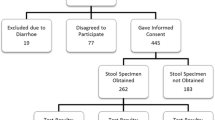Abstract
Introduction
Limited data exist on patient factors related to environmental contamination with Clostridium difficile.
Methods
We evaluated the association between the functional status of patients with C. difficile infection (CDI) and environmental contamination with C. difficile.
Results
Contamination of patient rooms was frequent and higher functional status was associated with contaminated surfaces remote from the bed. All but one environmental isolates matched the corresponding patient’s stool isolate for the seven patients tested.
Conclusion
Functional status is a factor that influences environmental contamination with C. difficile. Future studies should evaluate strategies to reduce contamination in CDI patient rooms, taking into account the patient’s functional status.

Similar content being viewed by others
References
McDonald LC, Killgore GE, Thompson A, Owens RC Jr, Kazakova SV, Sambol SP, et al. An epidemic, toxin gene-variant strain of Clostridium difficile. N Engl J Med. 2005;353:2433–41 [Research Support, U.S. Gov’t, Non-P.H.S.].
Sethi AK, Al-Nassir WN, Nerandzic MM, Bobulsky GS, Donskey CJ. Persistence of skin contamination and environmental shedding of Clostridium difficile during and after treatment of C. difficile infection. Infect Control Hosp Epidemiol Off J Soc Hosp Epidemiol Am. 2010;31:21–7 [Controlled Clinical Trial Research Support, U.S. Gov’t, Non-P.H.S.].
Vohra P, Poxton IR. Efficacy of decontaminants and disinfectants against Clostridium difficile. J Med Microbiol. 2011;60:1218–24 [Research Support, Non-US Gov’t].
Rao K, Micic D, Chenoweth E, Deng L, Galecki AT, Ring C, et al. Poor functional status as a risk factor for severe Clostridium difficile infection in hospitalized older adults. J Am Geriatr Soc. 2013;61:1738–42 [Comparative Study Research Support, N.I.H., Extramural Research Support, US Gov’t, Non-P.H.S.].
Guh A, Carling P; Environmental Evaluation Workgroup. Options for evaluating environmental cleaning. http://www.cdc.gov/hai/toolkits/Evaluating-Environmental-Cleaning.html. Accessed 23 Apr 2015.
Dumford DM 3rd, Nerandzic MM, Eckstein BC, Donskey CJ. What is on that keyboard? Detecting hidden environmental reservoirs of Clostridium difficile during an outbreak associated with North American pulsed-field gel electrophoresis type 1 strains. Am J Infect Control. 2009;37(1):15–9.
Dey BP, Engley FB Jr. Neutralization of antimicrobial chemicals by recovery media. J Microbiol Methods. 1994;19:51–8.
Zar FA, Bakkanagari SR, Moorthi KM, Davis MB. A comparison of vancomycin and metronidazole for the treatment of Clostridium difficile-associated diarrhea, stratified by disease severity. Clin Infect Dis Offi Publ Infect Dis Soc Am. 2007;45:302–7 [Randomized Controlled Trial].
Collin C, Wade DT, et al. The Barthel ADL index: a reliability study. Int Disabil Stud. 1988;10:61–3.
Dubberke ER, Reske KA, Noble-Wang J, Thompson A, Killgore G, Mayfield J, et al. Prevalence of Clostridium difficile environmental contamination and strain variability in multiple health care facilities. Am J Infect Control. 2007;35:315–8 [Multicenter Study Research Support, US Gov’t, P.H.S.].
Acknowledgments
We would like to thank Josh Smith, MS, at Streamline Diagnostics for the PCR method. Nasia Safdar is supported by grant number AG40669 from the National Institute on Aging, National Institutes of Health and a VA MERIT grant. The views in this paper do not necessarily represent the views of the Department of Veterans Affairs.
Conflict of interest
None reported.
Author information
Authors and Affiliations
Corresponding author
Rights and permissions
About this article
Cite this article
Blakney, R., Gudnadottir, U., Warrack, S. et al. The relationship between patient functional status and environmental contamination by Clostridium difficile: a pilot study. Infection 43, 483–487 (2015). https://doi.org/10.1007/s15010-015-0770-1
Received:
Accepted:
Published:
Issue Date:
DOI: https://doi.org/10.1007/s15010-015-0770-1




